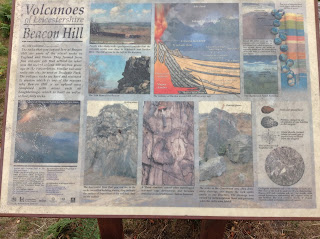We went up the Beacon to look down on Loughborough. The board says that the rocks are volcanic sediments that settled in the sea 600 million years ago. This is older that the Lake District. It counts as Precambrian. I am interested in the discussion of life in the Precambrian era because the Quantum Biology book I've been reading talks about the discovery of potential fossils in really, really old rocks in Greenland. The board talks about bedding planes in the rocks, which show the layers in which the ash landed on the seabed. Put later heat and pressure made the mineral crystals mobile and lined them up pointing up out of the beds, often at 90 degrees. This makes a cleavage and in slate is what gets cut to make the sheets.
















